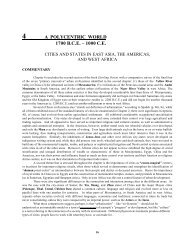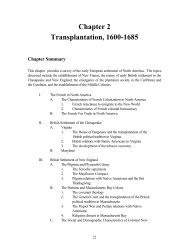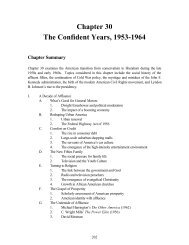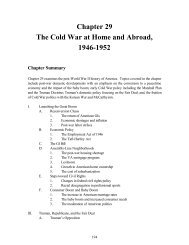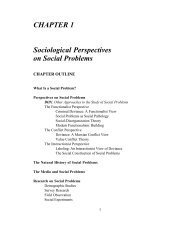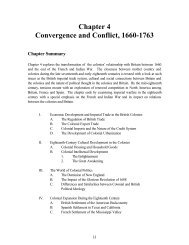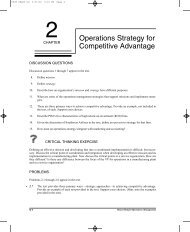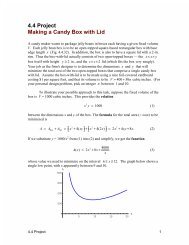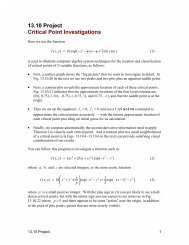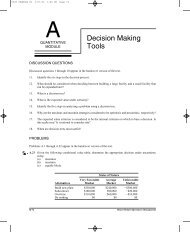Merchandising Operations and the Accounting Cycle - Pearson
Merchandising Operations and the Accounting Cycle - Pearson
Merchandising Operations and the Accounting Cycle - Pearson
Create successful ePaper yourself
Turn your PDF publications into a flip-book with our unique Google optimized e-Paper software.
STOP & THINK<br />
Why is <strong>the</strong>re no January 19 entry to Sales Revenue, Cost of Goods Sold, or Inventory?<br />
Answer: On January 19 <strong>the</strong> seller merely receives one asset—Cash—in place of ano<strong>the</strong>r<br />
asset—Accounts Receivable. The sales revenue, <strong>the</strong> related cost of goods sold, <strong>and</strong> <strong>the</strong> decrease<br />
in inventory for <strong>the</strong> goods sold were recorded on January 11. Examine <strong>the</strong> two entries<br />
on January 11.<br />
Offering Sales Discounts <strong>and</strong> Sales Returns<br />
<strong>and</strong> Allowances<br />
We just saw that purchase discounts <strong>and</strong> purchase returns <strong>and</strong> allowances decrease<br />
<strong>the</strong> cost of inventory purchases. In <strong>the</strong> same way, sales discounts <strong>and</strong> sales returns<br />
<strong>and</strong> allowances, which are contra accounts to Sales Revenue, decrease <strong>the</strong> revenue<br />
earned on sales.<br />
Credit subtotal<br />
Credit-balance Debit-balance accounts (not a separate<br />
account account)<br />
Sales<br />
Sales<br />
Sales Returns<br />
Net sales<br />
–<br />
–<br />
=<br />
Revenue Discounts <strong>and</strong> Allowances revenue*<br />
*Often abbreviated as Net sales.<br />
This equation calculates net sales. Note that sales discounts can be given on both<br />
goods <strong>and</strong> services.<br />
Companies keep close watch on <strong>the</strong>ir customers’ paying habits <strong>and</strong> on <strong>the</strong>ir own<br />
sales of defective <strong>and</strong> unsuitable merch<strong>and</strong>ise. They maintain separate accounts<br />
for Sales Discounts <strong>and</strong> Sales Returns <strong>and</strong> Allowances. Let’s examine a sequence of<br />
<strong>the</strong> sale transactions of JVC. Assume JVC is selling to Austin Sound Centre Inc.<br />
On July 7, JVC sells stereo components for $7,200 on credit terms of 3/15 n/30.<br />
These goods cost JVC $4,700. JVC’s entries to record this credit sale <strong>and</strong> <strong>the</strong> related<br />
cost of goods sold are:<br />
July 7 Accounts Receivable ................................................. $7,200<br />
Sales Revenue........................................................ $7,200<br />
Sale on account.<br />
July 7 Cost of Goods Sold .................................................... $4,700<br />
Inventory................................................................ $4,700<br />
Recorded <strong>the</strong> cost of goods sold.<br />
Assume <strong>the</strong> buyer, Austin Sound Centre Inc., returns goods that were sold by<br />
JVC for $600. These goods are not damaged <strong>and</strong> can be resold. JVC records <strong>the</strong><br />
sales return <strong>and</strong> <strong>the</strong> related decrease in Accounts Receivable as follows:<br />
July 12 Sales Returns <strong>and</strong> Allowances.................................. 600<br />
Accounts Receivable............................................. 600<br />
Received returned goods.<br />
JVC receives <strong>the</strong> returned merch<strong>and</strong>ise <strong>and</strong> updates <strong>the</strong> inventory records. JVC<br />
must also decrease cost of goods sold as follows (<strong>the</strong>se goods cost JVC $400):<br />
July 12 Inventory ..................................................................... 400<br />
Cost of Goods Sold ............................................... 400<br />
Returned goods to inventory.<br />
KEY POINT<br />
A contra account always has a<br />
companion account with <strong>the</strong><br />
opposite balance. Thus both Sales<br />
Discounts <strong>and</strong> Sales Returns <strong>and</strong><br />
Allowances (debit balances) are<br />
reported with Sales Revenue<br />
(credit balance) on <strong>the</strong> income<br />
statement.<br />
KEY POINT<br />
The sale of inventory <strong>and</strong> <strong>the</strong><br />
return of goods by customers<br />
require two separate journal<br />
entries.<br />
Chapter Five <strong>Merch<strong>and</strong>ising</strong> <strong>Operations</strong> <strong>and</strong> <strong>the</strong> <strong>Accounting</strong> <strong>Cycle</strong> 233



